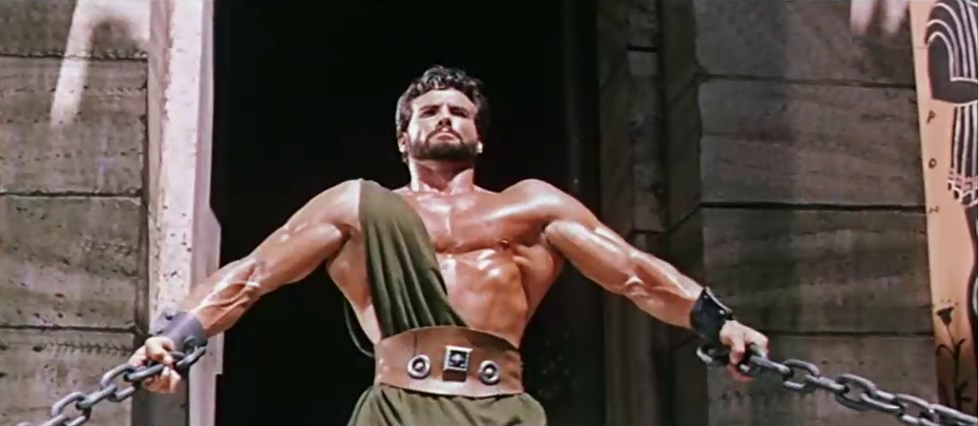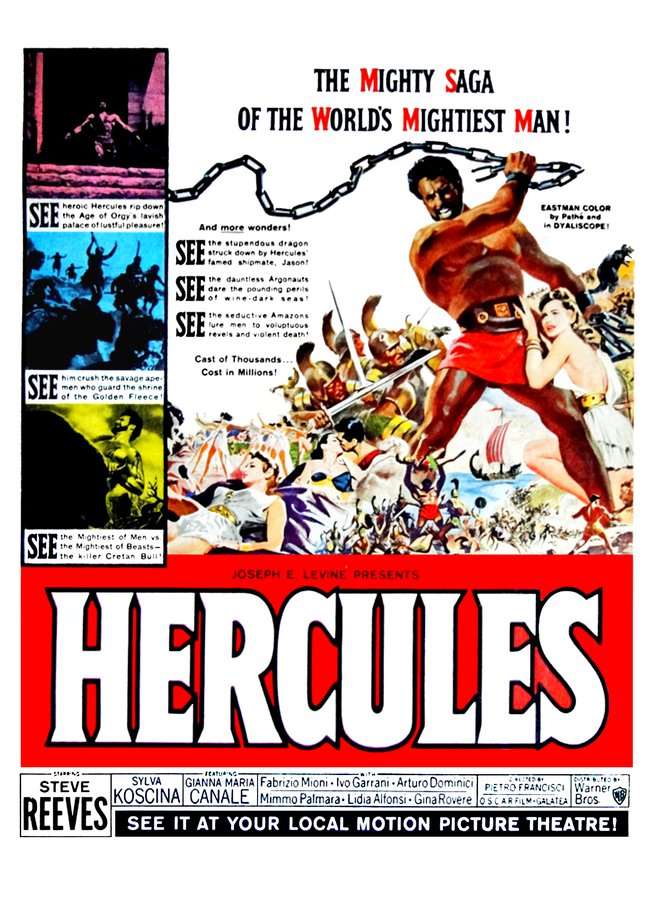
Steve Reeves made his cinematic breakthrough in 1958, with the movie Hercules. By the late 1950s, the sword and sandals genre was already becoming popular, but Reeves was the first performer to fully embody the physique of ancient Greek heroes on screen.
The immense popularity of Hercules and the other sword and sandals films set the stage for further silver-screen adaptations of Greek mythology and history. The genre continued to be popular throughout the 1960s and experienced a revival in the 2000s with blockbuster hits like Troy and 300.
Reeves also set a new standard for male action stars. As the first bodybuilder to enjoy mainstream cinematic success, he established new physical expectations for what an on-screen action star is supposed to look like.
Steve Reeves’ early life
Steve Reeves was born on January 21, 1926 in Glasgow, Montana in the United States. His father was killed in a work accident when he was young, and his mother relocated the family to Oakland, California.
Reeves’ strength training and bodybuilding journey began at the age of about fifteen after losing an arm wrestling match to a smaller classmate. After discovering that this classmate acquired his strength from weight training, Reeves started attending a nearby gym.
The future bodybuilding hall of fame athlete trained under gym owner Ed Yarrick in California. However, his athletic ambitions were interrupted by the Second World War. He enlisted in 1944 and was deployed to the Philippines.
After the war was over, Reeves studied at the California Chiropractic College in San Francisco.

Bodybuilding
What set Reeves apart from other stars of the sword and sandals genre was his towering physique. This was built during his bodybuilding career before his first major breakthrough in cinema.
In the sport of bodybuilding, Reeves is considered to be one of the all-time greats and is easily the most recognizable figure of the “silver era” of bodybuilding.
Reeves was competing before the now-iconic Mr. Olympia competition was founded in 1965. However, he won every other major accolade, including Mr. America in 1947, Mr. World in 1948, and Mr. Universe in 1950.
When Reeves won Mr. America, a columnist in Your Physique magazine wrote: “I, personally, proclaim him to be the finest specimen of American manhood I have ever seen in a kid of his years. He hasn’t a single weak spot in his make-up…He seemed from out of this world, just as though a Superman had suddenly appeared on a pedestal.”

Reeves becomes Hercules
The successful bodybuilder had been appearing in small television and movie roles since the late 1940s. However, the film that put Reeves on the map was Hercules, directed by Italian director Pietro Francisci and released in 1958.
Francisci flew Reeves out to Italy to shoot the film on a relatively low budget. The movie’s plot was a mixture of Greek mythological stories. Reeves starred as Hercules (Herakles), the impossibly strong demigod and son of Zeus. However, the plot more closely followed the story of Jason and the Argonauts.
Hercules was popular upon its release in Europe. The film became a major box-office success after American film distributor and producer Joseph E. Levine bought the rights for the movie’s distribution in the US. American audiences loved the film, and it grossed five million dollars in the US.

Hercules Unchained and other ancient Greek adventures
A sequel was released in 1959. Like its predecessor the year before, Hercules Unchained featured the titular character immersed in a story that was a combination of Greek myths meshed together rather than an exact retelling.
Hercules Unchained was loosely inspired by the Greek mythological tale of the Seven against Thebes. The Greek hero Ulysses (Odysseus) also makes an appearance in the story.
The success of Hercules and its sequel encouraged other directors to adapt Greek mythology and history to the silver screen. Reeves was cast as the heroic Greek protagonist in these movies as well.
In The Giant of Marathon, also released in 1959, Reeves starred as Pheidippides, an ancient Athenian hero and spiritual founder of the marathon race. The movie’s plot loosely follows the events of the Battle of Marathon, which took place in 490 BC between Athens and the invading Persians.
In 1961, Reeves starred in The Trojan Horse, an on-screen adaptation of Homer’s Iliad. This time, Reeves’ character was pitted against the ancient Greeks, as he played the Trojan hero Aeneas. John Drew Barrymore was also in the film as Odysseus.
Legacy
Steve Reeves’ legacy is twofold, both in the worlds of cinema and bodybuilding. He was able to imbue a physicality into his performances that was necessary to bring the larger-than-life heroes of Greek mythology and history to the silver screen.
Thanks to Reeves, other bodybuilders had a blueprint to follow when transitioning into the world of cinema. Other big names in the sport also found success portraying Hercules, most prominently Lou Ferrigno and Arnold Schwarzenegger.
As the first bodybuilder to make a big impression in the world of film, Reeves also had a profound influence on the aesthetics of cinema. The muscular and athletic physiques of contemporary action stars were hitherto unseen until Reeves’ appearances in cinema.
To this day, the athletic aesthetic and ancient Greece remain inseparable in cinema. Gerard Butler reportedly worked out for six hours every day to prepare for the role of King Leonidas in 300, which portrayed the heroic last stand of the Spartans at Thermopylae. Brad Pitt similarly had to appear in peak physical fitness to play Achilles in Troy.
See all the latest news from Greece and the world at Greekreporter.com. Contact our newsroom to report an update or send your story, photos and videos. Follow GR on Google News and subscribe here to our daily email!



